This page is to feature all the GTX 7XX series graphics cards that I have worked on.
Why like the 7 series?
- The GTX 750 TI was a classic and still a viable desktop card with the option of light gaming. The main limiting point for modern gaming is the relatively low VRAM sizes. However, look out for the rare high-memory versions e.g. GTX 750 TI/760/770 4Gb and GTX 780 6Gb!
- As a card to repair, there are plenty on the market, they’re cheap and I find the PCB layout relatively easy to understand.
- Not very power efficient by modern standards, but strangely I haven’t seen so many cards with PCB burns etc. A typical problem would be the VRAM, especially on the larger cards due to board flex e.g. 770 and above.
- The 780 and 780 TI are still fairly able for HD gaming with lower memory-related settings.
Typical Issues
- The 760 and above very often VRAM issues, typically the chip closest to the PCI slot on larger cards, but can be others too. Identify the failing chip with MATS and fix it by following Graphics Card VRAM Chip Replacement Procedure
- Issues related to age and general wear and tear. Missing capacitors seem quite common, especially on versions without back plates. Often the missing capacitors will be around VRam areas as well as on the PCI lanes (see Palit GTX 750 TI STORM X OC for a walkthrough on fixing PEX capacitors).
- Relatively high running temperatures on the GTX 770 and above.
Less Common Issues
- I have not seen many 7 series cards with shorts, PCB burns.
Repair Notes on 7 Series
Like 9 series, the 7 series have no 1.8V rail.
| Voltage Rail | Typical Resistance |
|---|---|
| VCore | ~2-12Ω (Varies, 780 TI tends to be on the lower end) |
| VMem | ~80-120Ω (Samsung – Hynix), 750 TI can be higher (~475Ω Elpida, ~50Ω Samsung) |
| PEX | ~170-320Ω (typically 200+, I have never seen any <100Ω) |
| 5V | ~2-3KΩ |
| 3.3V | ~600-900Ω |
| 12V | 2KΩ+ |
GTX 710
I really need to just take some time to sort these cards out! I bought most of them cheap a while ago. Now my skills have moved forward, some of them might be fixable when revisited.
- ASUS GT 710 2GB GDDR5 SILENT (Initially artefacts, but then ran fine, more testing required – possible bios read issue?)
- MSI 710 2Gb – Card A (Seemingly OK, Furmark/Heaven/Roblox, but crashes when starting Kombuster, so must in fact have an underlying issue – memory perhaps?)
- MSI 710 2Gb – Card C (WORKING – Seems fine, no problems observed)
- MSI 710 1Gb – Card B (WORKING – Bad corrosion, not safe to test without careful cleaning, probably spare parts at best – update, missing a couple of capaitors behind the GPU, but seems to actually work! Needs more cleaning, back plate replaced and probably transfer the capacitors from the Card D which I suspect has a faulty GPU)
- PALIT GEF GT 710 2GB SILENT DDR3 (resistances OK, voltages OK, seems to work correctly, although wise to test further)
- ASUS GT 710 2GB SILENT DDR3 710-2-SL (resistances OK, voltages OK, got to windows on the first run, now won’t – blank screen – when GT 710 driver setup previously by another card, this card then seems to reach windows and work without artefacts)
- ASUS GT 710 2GB GDDR5 (K7C0YZ04R493ZUA) (very similar, but slightly different to the other one) (Interesting, missing VMem & VCore, can hopefully use the other semi-working 710 to compare some voltages)
GTX 730
- ASUS GT 730 2 GDDR5 Silent (Has a short on the 5V rail)
- Palit GT730 2Gb (WAS WORKING, NOW FAULTY – DVI port replacement / resolder needed. For months I used this as a test card, so it had a tough time. Now it is not detected, perhaps the core failed, as I can see all the voltages)
GTX 750 ti
A classic for me! If you’d like to learn graphics card repair, I would say it could be a great card to start with due to having mainly PCB / circuit-related issues rather than burns and BGA issues. Still a useful desktop and light gaming card.
Deep Dives

MSI GTX 750 TI OC (X10 Multiple Issues Covered) (bought 10 of these in a bundle, 4 worked, multiple fault types across the other 6 e.g. missing PEX, crashing, missing 5v, physical damage, short, VRAM)
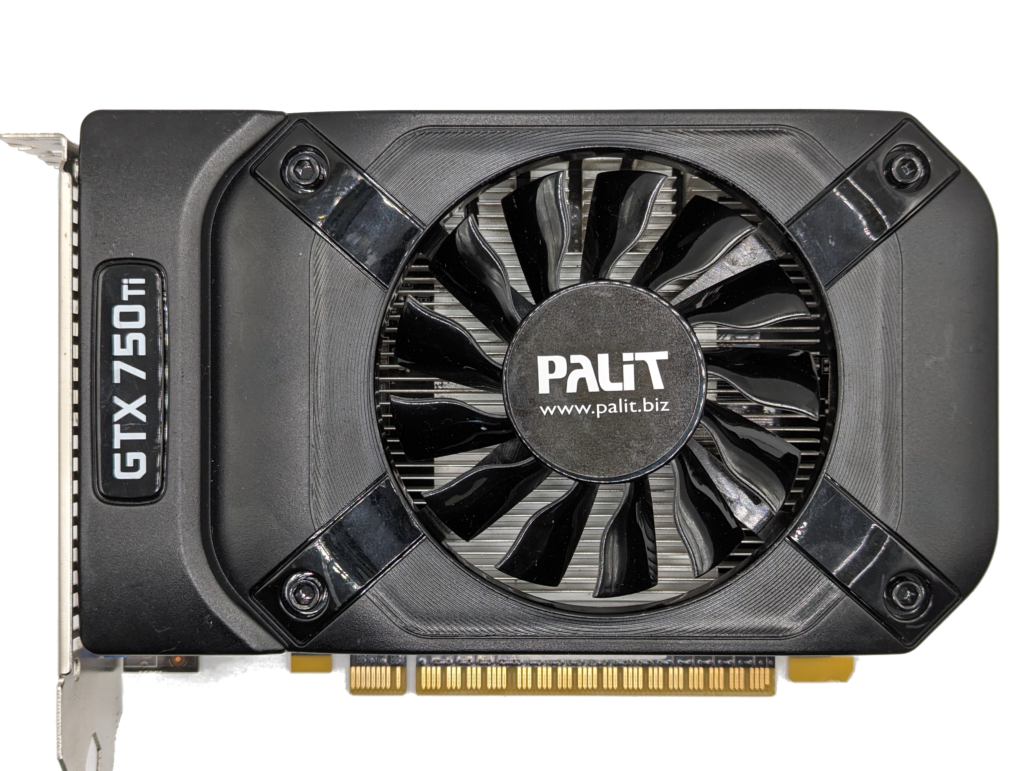
Palit GTX 750 TI STORM X OC (FIXED – Working with 4 missing PEX capacitors, lowering PEX speed to x2 from x16. See this one for a walkthrough of repairing PEX capacitors)
Others
- MSI GTX 750 TI Twin Frozr (Crashes on driver load, failing B1 VRAM chip in MATS)
- Kfa2 GeForce GTX 750 Ti 2GB GDDR5 (missing VCore, VMem – Some issues resolved)
- EVGA 2GB GTX 750 TI GDDR5
- GTX 750ti 2GB FAKE
- GIGABYTE Graphics Card GV-N75TOC-2GL (Seller “displays but with lines.” – Lines on screen, and a very low Vmem resistance, felt one very hot chip, also levered up! Never seen that before!!)
- ASUS GTX 750 Ti OC 2GB (SCRAP grade B – Free card, core physically damaged, not detected, all voltages, resistances OK)
GTX 760
- EVGA GTX 760 SC w/ ACX 4Gb (FIXED – Interesting 4Gb version, had 3 Ohms on the VMem rail due to a faulty VRAM chip. After fixing this the card works, some missing capacitors to fixed)
GTX 760 ti (rare)
- GTX 760 Ti 2GB GDDR5 Alienware OEM (Vcore VRM short, runs without the faulty MOSFET, needs replacement)
GTX 770
Still OK for low-end HD gaming, although the rarer 4Gb versions have a definite edge.
- Zotac GTX 770 4Gb (Seller advised that it gets a blank screen under load. I haven’t seen this yet, but expect thermal shutdown, as the temperature was >90 deg C under load and probably would climb further. MATS test passed)
- EVGA GTX 770 2Gb SC /w ACX (FIXED – Failing A1 chip, replaced. Testing well)
- Gainward GTX 770 4Gb (multiple failing VRAM chips, could be memory controller?)
- Gigabyte GTX 770 Windforce 2Gb GV-N770oC-2GD (MATS errors on multiple banks)
- Windforce GV-N770oC-2GD (artefacts on driver load, small number of MATS errors)
- MSI GTX 770 4Gb (Card A) (Runs at full speed and stable, but crashes when the load is removed, clicking noise noticed when this happens, choppy GPU graph in GPU-Z)
- MSI GTX 770 Gaming 4 GB (Card B) (has artefacts, hoping it’s just VRAM and I can use it to help me fix Card A. MATS indicates failing C0 chips)
- MSI GTX 770 4Gb (Card C) (Display in low-res only with error 43, Failing B1 VRM chip in MATS)
- MSI GTX 770 2GB (2048 MB) Twin Frozr (A) (FIXED, VRAM chip A1 replacement – SOLD)
- MSI GTX 770 2GB (2048 MB) Twin Frozr (B) (FIXED, VRAM chip A1 replacement – SOLD)
GTX 780
The GTX 780 can still deliver decent HD gaming, these are my favourites that I have worked on:
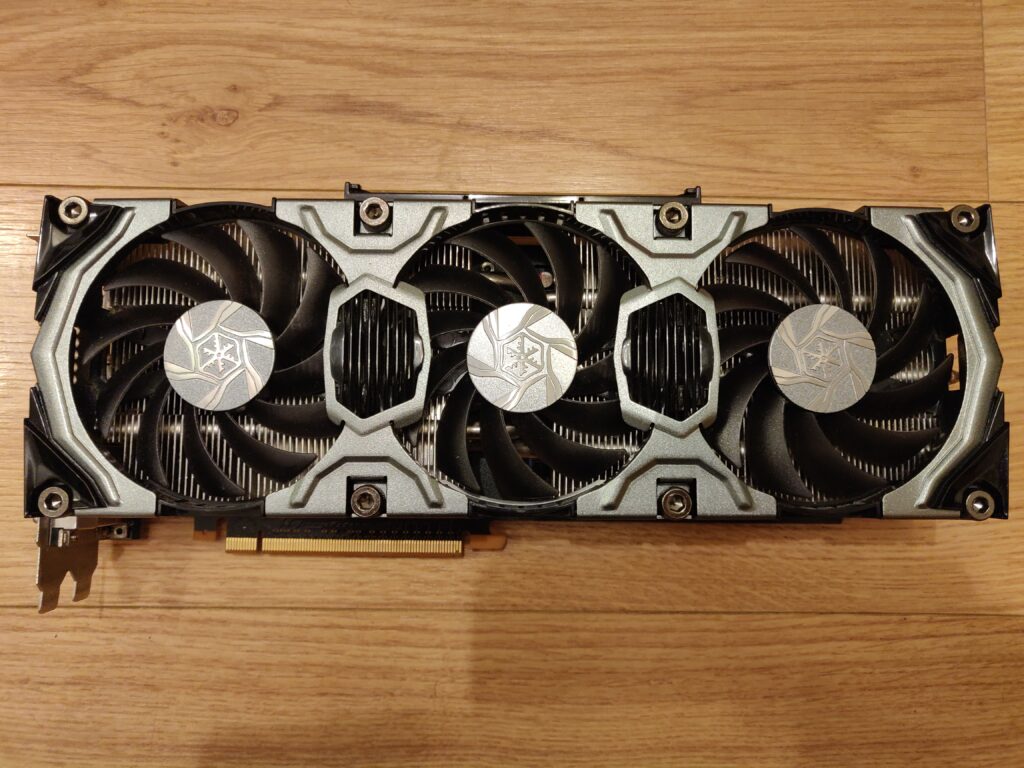
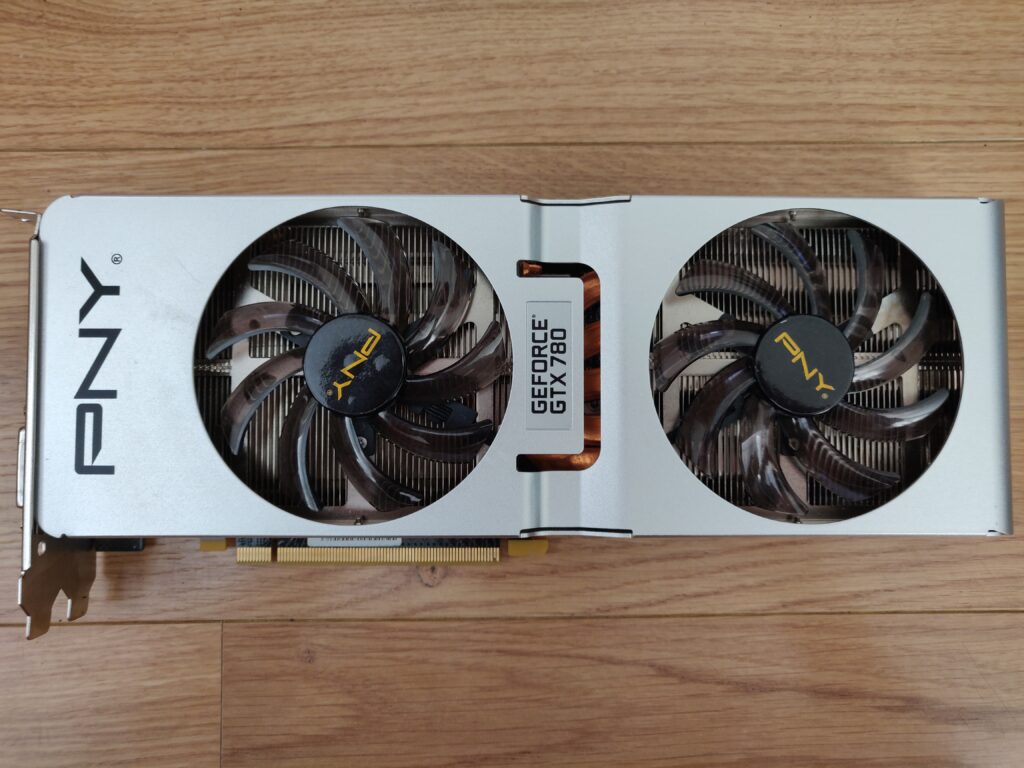
- Inno3D iChill GTX 780 HerculeZ X3 Ultra DHS Edition (FIXED – Had a failing E1 VRAM chip, had no idea just how good this card is! I wan’t to complete the refurbishment and then make it a featured 780)
- EVGA GTX 780 SC w/ ACX Cooler 6 GB (Excited to get this card, the rare 6Gb version! It was donated to me by a kind eBay seller in return for me blogging it, will have to up my game! The card appears to have low resistance on the VRM rail)
- EVGA GTX 780 Dual FTW w/ ACX Cooler (PARTIALLY FIXED – Had corrosion and sporadic boot issues, resolved the corrosion, has a memory chip issue and somebody else’s badly repaired PCI lane capacitors to fix)
- EVGA GTX 780 3Gb SC (Card B) (SCRAP – Suspected dead core from VRAM short, scrap)
- MSI GTX 780 Twin-Frozr (FIXED, IN TEST– Has VRam issue on E1, damaged caps)
- PNY GTX 780 XLR8 3Gb (FIXED – fans spinning fun speed, not detected in Linux, suspect dead core – Actually it had a missing 5v rail due to a missing diode, no idea where it went!)
- GIGABYTE WINDFORCE GV-N7800C-3GD (FIXED – Short on 5v rail)
Reference Type
I am still trying to get a level view of what a good example of the reference GTX 780 should run like, the short answer seems to be hot and with regular thermal limiting under full load! I will not buy more reference types due cooler design having relatively poor thermal performance and how much hassle it is to work with (lots of screws and thermal pads need to be just right to avoid stressing the PCB and components). It is an OK choice for practice or spares though, as most of the layout and components are similar in other 780s.
- Reference GTX 780 (FIXED – VRAM issue)
- Reference GTX 780 Card B XS Waterblock (Seller Note “Card boot’s into Windows using default driver’s once windows installs Nvidia driver’s the screen goes blank.”)
- EVGA GTX 780 3Gb (Card A) (FIXED, missing resistor and capacitors to solder on near memory and on PCI lanes, thermal limiting issues remain)
- EVGA GTX 780 3Gb (Card B) (FIXED, had a failing chip F0, bad artefacts, missing some PCI and memory capacitors)
- EVGA GTX 780 3Gb (Card C) (FIXED, AWAITING MORE TESTS, 1 failing VRAM E0, wrong screws and thermal pads in places)
GTX 780 TI
The ultimate 7 series cards! The Gigabyte GTX 780 TI 3Gb GHz Edition is my favourite version that I have worked on – Why?
- Understated, but practical design and cooler (~typically low 70 deg C range)
- Joint highest Core boost clock of 1150 MHz of all GTX 780 TI cards
- Legendary score in 3D Time Spy using default settings!
- The regular Windforce version also does almost as well.
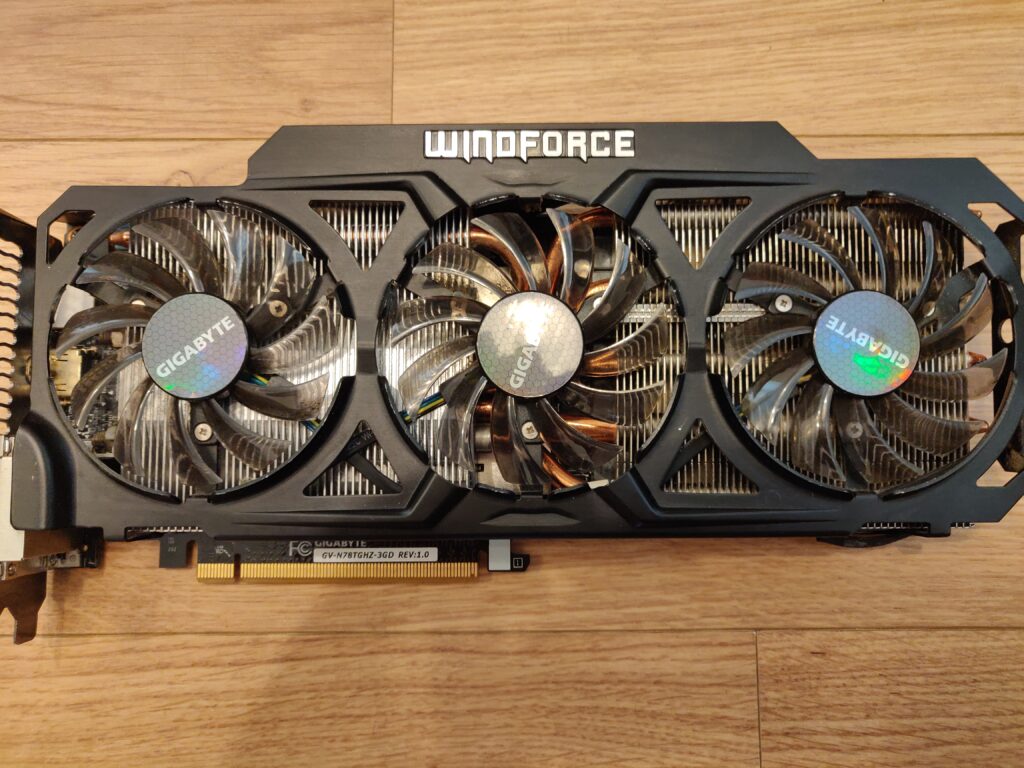
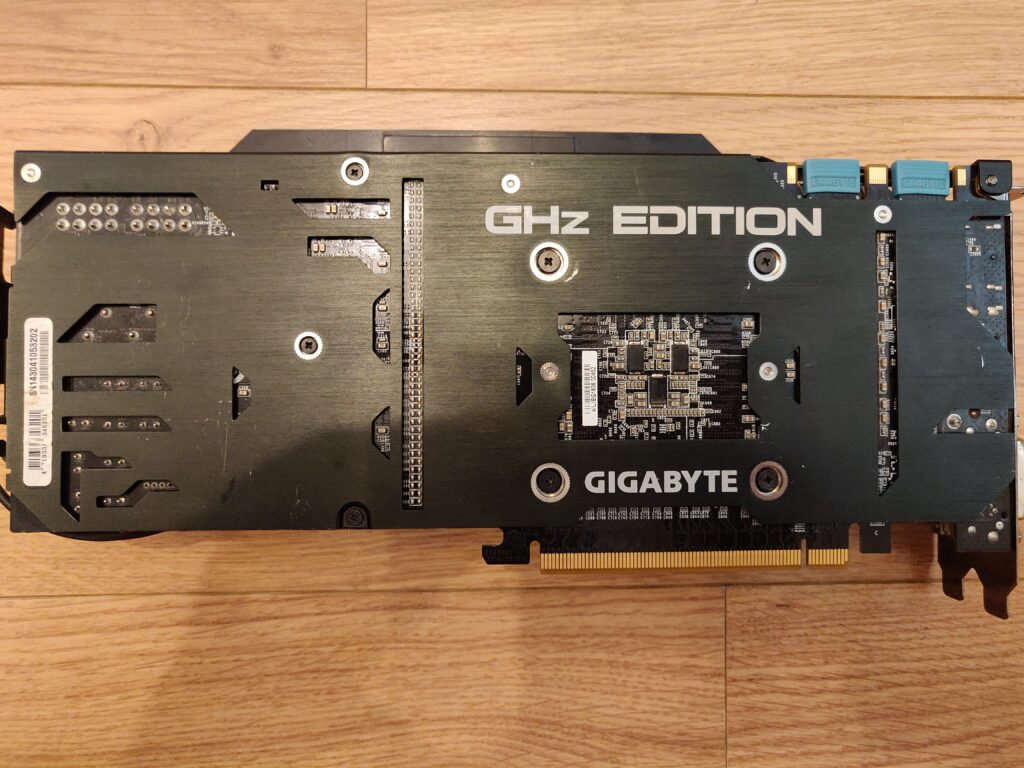
- Gigabyte GTX 780 TI GV-N78TOC-3GD Windforce (Card A) (SEMI FIXED, UNSTABLE – MATS failing A1 chip replaced)
- Gigabyte GTX 780 TI GV-N78TOC-3GD Windforce (Card B) (Seller Note “wont boot” – could have a GPU issue, but I cannot prove this yet. Unusual error message in MATS, possibly a BIOS issue?)
- GIGABYTE GTX 780 TI WindForce 3X (Card C) (FIXED – Had a failing E1 VRAM chip)
- Gigabyte GTX 780 TI 3Gb GHz Edition (FIXED, LATER FAILED – VRAM chip A1 issue)
- Zotac GTX 780 TI 3GB (possible VRAM issue, but has 2 failing chips, so worth measuring resistances under the faulty chips in case the core has faulty pads)
- Zotac GTX 780TI 3GB (card B) (WORKING – Despite initially having no output, after loading drivers, this card strangely seems to work – needs thorough testing to confirm)
- EVGA GTX 780 TI (SCRAP – suspected dead core, cannot prove, but probably beautiful looking scrap)